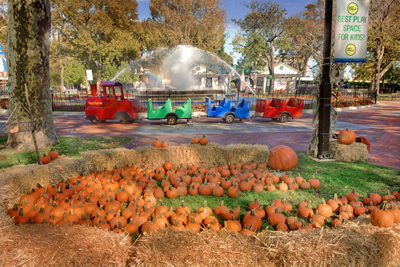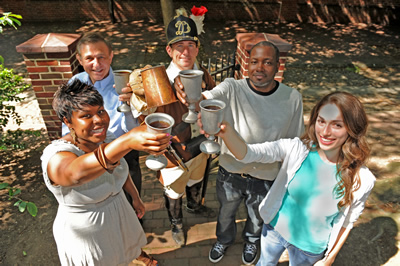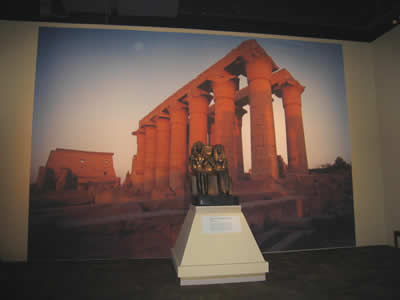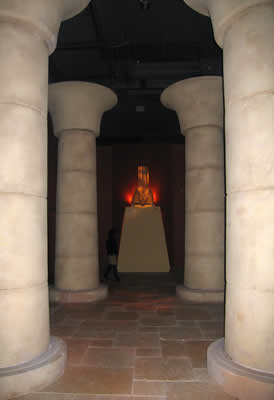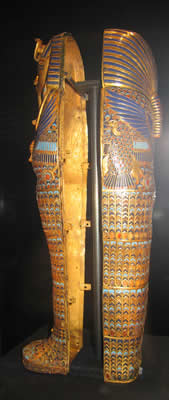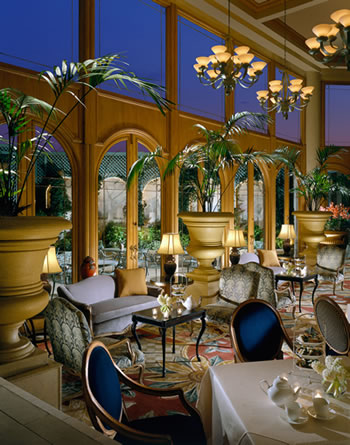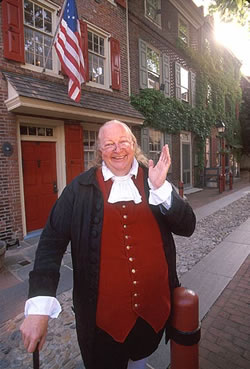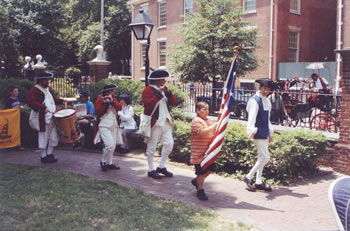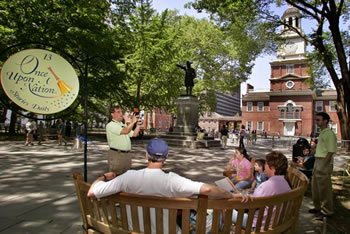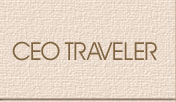 |
|
|
|
|
|
|
|
|
|
|
|
|
|
|
|
|
|
|
|
|
|
|
|
|
|
|
 |
 |
|
|
|
|
|
|
|
|
|
|
|
|

|
Make History Fun Historic Philadelphia Offers Family Activities Looking for some unique ways to fill the days before school starts. Historic Philadelphia, Inc. has tons of off-the-beaten path things to do for families, many free or low-cost. Try a visit to Historic Philadelphia or Valley Forge. Through Labor Day weekend, Historic Philadelphia, Inc. entertains visitors and residents with stories of the nation's past in modern, fun, and engaging ways, winning awards and mesmerizing guests. While some programs continue into the fall, the full array of free programming continues only until Labor Day Weekend. Experience Once Upon A Nation tours for families, visit the Storytelling Benches, and meet History Makers on the cobblestone streets of Philadelphia's historic district and on the rolling hills of Valley Forge now through Labor Day. Last Chance for Children's Tours and Free Programs
Through the end of the month, families can see history come alive on charming tours offered for children: Colonial Kids' Quest Tour and Valley Forge Secrets and Spies Tour, where young visitors become part of the action alongside George Washington or Benjamin Franklin to help save the day. Or visit the 13 one-of-a-kind award-winning Once Upon A Nation Storytelling Benches throughout Historic Philadelphia and three Once Upon A Nation Storytelling Benches at Valley Forge where specially-trained storytellers in modern uniforms delight and entertain with short 5-minute stories about our nation's history in the places where they actually happened. History Makers, the costumed interpreters from Philadelphia's past, conduct a host of free daily programs to meet and greet visitors, regale them with tales from their times, and perform regular dramatic readings throughout the day. Through Labor Day, meet recognizable faces like Betsy Ross and Benjamin Franklin, or be introduced to some lesser-known headliners from days gone by such as Oney Judge, Octavius Catto, or Major Samuel Nicholas. Begin the day with the Flag Raising at the Betsy Ross House at 10 am, hear a dramatic reading of the U.S. Constitution featuring the words of the abolitionist Frederick Douglass at We The People at 12 noon on Independence Mall, have kids join the Continental Army at 2 or 3 pm in the Military Muster, or greet all the History Makers behind Independence Hall at the Declaration Reading each day at 3:45 pm. Meet them, take photos with them, and the memories will linger forever. Historic Philadelphia, Inc. (HPI) is a non-profit organization overseeing four entities under one umbrella. Once Upon A Nation features Adventure Tours (one-of-a-kind immersive experiences), History Makers, Storytelling Benches throughout the Historic District and at Valley Forge, and the Benstitute to specially train all staff. Franklin Square is an outdoor amusement oasis with Philadelphia-themed Mini Golf, the Philadelphia Park Liberty Carousel, and SquareBurger, hosting birthday parties and many special events. Liberty 360, a new digital 3-D experience, is the year-round indoor attraction housed at the remodeled Historic Philadelphia Center as Phase I of the all-new completely re-imagined Lights of Liberty. The Betsy Ross House allows visitors a personal look at the story and home of a famous historical figure, with newly remodeled and reinterpreted rooms and a new Civil War exhibit. "Historic Philadelphia, Inc. brings history to life in a wide variety of ways that appeal to visitors and residents alike," said Amy Needle, President and CEO of Historic Philadelphia, Inc. "At free storytelling benches to behind-the-scenes at night in Independence Hall, from beloved Franklin Square to our newest attraction in 3D, our storytellers, History Makers, and Benstitute-trained staff work hard to create memories for everyone who experiences our offerings." Franklin Square Celebrates 5th Birthday Season
Franklin Square, now celebrating five seasons of fun, is open 7 days a week for a round of Philly Mini Golf, a spin on the carousel, a quiet respite by the vintage fountain, or a delicious meal with mouth-watering burgers and the best shakes in town. Franklin Square just celebrated its 5th Birthday, and continues the festivities on Saturday, October 29, 2011, with the PumpkinFest special fundraising event for families from 3-6 pm. Also in the Square, the renowned SquareBurger, operated by Starr Restaurants in partnership with Historic Philadelphia, presents a delicious menu featuring burgers, a variety of other foods, and delectable frozen treats such as the Philadelphia Magazine Best of Philly 2011 winner Cake Shake with Tastykake Butterscotch Krimpets. Try a Birthday Bonanza Sundae in honor of the Square's 5th Birthday; a delicious With Love, XOXO Strawberry Sundae; or the popular Shake-of-the-Month for August: Cocoa Banana. 21st-Century Technology Lights Up High-Tech History Year-Round Escorted by Benjamin Franklin and continuing all year, Liberty 360 immerses the viewer in the symbols of freedom in a groundbreaking 360-degree, 3-D show unlike anything that has ever been seen before. The 15-minute, 3-D film surrounds the audience in the new customized state-of-the-art PECO Theater. The theater is housed in the newly renovated Historic Philadelphia Center, across the street from Independence Hall and the Liberty Bell. The Historic Philadelphia Center is the headquarters for all of Historic Philadelphia's programs including the box office, providing tickets for Once Upon A Nation tours, Liberty 360, as well as the nearby Betsy Ross House and Franklin Square. The Center also serves as the departure point for all Once Upon A Nation Adventure Tours, provides guest services such as restrooms, and offers expanded retail operations. Some Tours Continue in the Fall
Some of the most memorable programs produced by Historic Philadelphia, Inc. are the immersive tours where visitors are escorted by costumed interpreters called History Makers who truly bring the history to life. The Independence After Hours Evening Adventure Tour (Fridays and Saturdays through October 22) is a walking tour of some of the landmarks of Historic Philadelphia where guests walk through the shadows of Independence Hall (in this unique opportunity to visit inside the Hall at night, with no crowds) and experience what those late nights of the summer of 1776 were like for the Founding Fathers. (Tour includes dinner at historic City Tavern and exclusive visit to Independence Hall with the Founding Fathers.) One of HPI's most popular programs is the Tippler's Tour (Thursdays through December 22), a light-hearted tavern tour of Colonial and modern-day watering holes. A Colonial host shares historical facts about the traditions of drinking and leads guests in Colonial drinking songs and toasts with drinks and snacks at four Old City locations. The popular Valley Forge After Hours Tour travels back in time to June 1778, where visitors spend an exciting evening at the famous encampment and see what nights were like for the Continental Army under the leadership of General George Washington. Enjoy a traditional Colonial dinner with Martha Washington before checking in at the General's Headquarters and then relax around the group campfire and listen to the soldiers' tales (Saturdays through October 22). Meet Betsy and See New Exhibits at the Betsy Ross House Through Labor Day Weekend, at one of Philadelphia's most popular historic attractions, the Betsy Ross House, join Betsy herself and some History Maker friends raising the flag at 10 am to signal the start of the day. Afterwards, tour the restored house, where Betsy Ross, as the story tells it, created the first American flag. Visit with her as she works covering chairs, making window coverings and more in the country's only 18th century upholstery shop. Ask her how she came to make our country's first flag and learn the secret snip behind the five-pointed star. A fully-restored flag made by Betsy Ross' daughter, Clarissa Claypoole Wilson, is on display at the Betsy Ross House for the first time ever as part of the current exhibit. The Civil War era 34-star silk flag is one of the highlights of "Rally 'Round the Flag: Civil War Color Bearers and the Flags They Carried," which runs through April 2012 in commemoration of the 150th anniversary of the start of the Civil War. Or, if you're already planning for fall, Historic Philadelphia has some terrific activities scheduled, especially in Franklin Square, with a new event, PumpkinFest, on October 29. Download the Fall Schedule here: http://historicphiladelphia.org/press-releases/. Historic Philadelphia, Inc. makes our nation's history relevant and real through interpretation, interaction, and education, strengthening Greater Philadelphia's role as the destination to experience American history. Historic Philadelphia, Inc.'s programs include the Betsy Ross House, Once Upon A Nation storytelling and Adventure Tours, Franklin Square, and Lights of Liberty. For all Historic Philadelphia, Inc. event information, call 215-629-4026, 877-462-1776, or visit www.historicphiladelphia.org to buy tickets online. Tickets available in person at the Historic Philadelphia Center, Betsy Ross House, Franklin Square, or the Independence Visitor Center. Follow HPI at http://twitter.com/HistoricPhilly and http://twitter.com/FranklinSqr or on Facebook at http://tinyurl.com/facebkHPI or http://tinyurl.com/facebkFnkSq. (For hours, days, and pricing for all attractions, see Historic Philadelphia, Inc. 2011 Season Fact Sheet or to view or download the entire Historic Philadelphia, Inc. electronic press kit, go to http://historicphiladelphia.org/press-releases/. Historic Philadelphia, Inc. 2011 FALL SCHEDULE also available for download.) Source: Historic Philadelphia, Inc. Summer, 2011 PHILADELPHIA Tutanhkamun and the Golden Age of the Pharaohs Franklin Institute Science Museum
Betsy Ross, Haym Soloman, Ben Franklin, and all the other colonial figures that draw visitors to Philadelphia are getting major competition from another historic headliner, Tutankhamun, the boy king who ascended the Egyptian throne in 1332 B.C. at age nine and ruled until he passed away 10 years later. The blockbuster exhibit "Tutankhamun and the Golden Age of the Pharaohs" traveled across America and is making its last stop at the Franklin Institute in Philadelphia where it remains until the end of September, 2007 before going on to London and returning to its permanent home in Cairo. Consisting of more than 130 objects dating back some 3,300 to 3,500 years ago, these treasures were retrieved not only from Tut's tomb, but from those of his royal relatives.
Another exhibition "The Treasures of Tutankhamun" visited seven U.S. cities in the late 70s. Even if you had the privilege of seeing that show, as I did, you will want to take in this one as few of the antiquities on display presently were part of the earlier tour. Many historians contend that Tut was the son of the heretic king, Akhenatun, who with his wife, Nefertiti, changed the official religion. Because of his lineage, the pharaohs who came after Tutankhamun may have deliberately excised any traces of his being from historic documents. This act reversed the legacy of the boy king. Thieves robbed the burial grounds in the Valley of the Kings of the later pharaohs and their contents disappeared forever. Tut's tomb remained secreted for several millennia and its artifacts protected for posterity.
During the early 1800s European and American scholars explored the Valley, discovering riches of all kinds. In 1899 Howard Carter, an English archeologist, also began excavating royal tombs, but not until 1922 did he discover the miraculous necropolis devoted to the ruler who sat on the ancient Egyptian throne at the end of the 18th dynasty. Writing about what he found, Carter said, "strange animals, gold, everywhere the glint of gold... wonderful things." Omar Sharif, appearing in a 90-second film, introduces the chronicle of pharaonic existence that is displayed in a series of chambers. Dedicated to aspects of ancient Egypt, the galleries conceptualize daily life; traditional beliefs; religious revolution, the focus on a single god; death, burial, and afterlife; and the tomb. http://www.kingtut.org/about_the_exhibition Open the link and click on Preview Included among the collections are model boats, human-sized statues, jewelry fashioned from gold and gems, inlaid chairs and furniture, calcite bowls, and stone and wooden pieces. Of the scores of articles that were entombed, many were never used by the nobility, but were buried with them to assure secure transition to the afterlife. The masterly craftsmanship of the showcased items reveals the advanced state of culture and the arts during the pharaonic era.
A few of our favorite items associated with Tutankhamun: a miniature viscera coffin fabricated from gold, colored glass, and semi-precious stones, which held the mummified liver; a tiny delicately inscribed game board carved out of an ivory slab with a drawer to hold the game pieces; a painstakingly detailed necklace (pectoral) made from gold and set with electrum, stones, silver and glass; a ceremonial dagger formed with solid gold and a sheath; and two earthenware ankhs covered with opaque blue glaze (faience).
A team traveling from Egypt worked on the installation and was overseen by Howard Silverman, the curator, and Zawi Hawass, Secretary General of Egypt's Supreme Council of Antiquities. Designed to showcase each piece with maximum perfection, the powerful setting could not be more exquisitely matched to the contents: panoramic photographs; a cream-colored carpet that feels and looks like sand; a floor composed of oblong and square stones; a corridor of columns simulating a temple; beige and occasionally black linen lining the bottoms of the display cases to offset details of the artifacts; walls painted in an earthy brick color or covered with hieroglyphs; and background music from Egypt. To complement the lead show, supplementary experiences about ancient Egypt take place in other wings of the museum. Against a backdrop of recreated spectacular temples and tombs, "Stars of the Pharaohs" plays in the Fels Planetarium. The story line follows the application of the science of astronomy to tell time, draw calendars, and align large buildings during the days when people felt a divine connection to astral phenomena. The Tuttleman Imax Theater hosts two films: "Mysteries of Egypt" and "Mummies: Secrets of the Pharaohs." "Mysteries" introduces audiences to marvels of construction produced 5000 years ago. With Omar Sharif as your guide you descend over the Nile, and fly across the pyramids of Giza and the Valley of the Kings before settling into King Tut's tomb. "Mummies" combines a forensic inquiry and an historic trip as researchers and explorers examine archeological and biological clues to uncover the world of the pharaohs. The Franklin Institute Science Museum, 222 N. 20th Street, Philadelphia, PA 19103
As an adjunct installation to the one at Franklin Institute, the University of Pennsylvania Museum of Archeology and Anthropology organized Amarna, Ancient Egypt's Place in the Sun. More than 100 artifacts from Amarna, the royal city where Tutankhamun grew up, are on display. Penn Museum owns a large collection of ancient objects including the columns and doors from an excavation of the Temple of Memphis. University of Pennsylvania Museum of Archeology and Anthropology, 3260 South Street, Philadelphia, PA 19104, Tel. 215-898-4000
After spending three- and one-half hours of an afternoon at the Tut exhibit, the following morning I visited Amara and although worthwhile, I squeezed too much Egyptology into one time frame. For maximum enjoyment, schedule another activity in between. The ubiquitous hop-on hop-off big red trolley buses that transport visitors to important attractions in major cities have a new look in Philadelphia. Painted black and decorated with gold hieroglyphs and an image of the boy king's face, the Tut Trolley carries passengers between city landmarks and Egypt-related venues--The Franklin Institute and Penn Museum.
Where to Stay
When William Penn founded Philadelphia in 1681, he placed a sylvan square in the middle of a gridiron and then laid out a London-style commons in each tree-lined quadrant. Drawings of colonial days show residents gathering in small parks and enjoying a respite from the town's bustling commercial life. Among these centrally located green oases, the addresses that border Rittenhouse Square--Rittenhouse Place, 18th, 19th, Walnut and Locust Streets, and the environs--enjoy the city's best zip code and register a "ten" on the social cachet meter. With its diagonal paths converging onto a central fountain the logo of the acclaimed Rittenhouse Hotel is a replica of the plan of the park. The kindred mood of the urban playground and the hostelry on West Rittenhouse Square, a winner of countless awards, decrees that they share the same ideogram. Intrigued by the people who hang out in the Square, the level of activity, and its status as an urban and cultural icon, filmmakers Robert Downey, Senior and Max Raab produced an opus showing a year in the life of the park. The movie "Rittenhouse Square" debuted on January 1, 2005 at a Philadelphia film festival and later went mainstream. Critics especially took note of the sound track as many of the regulars are students at the nearby Curtis Institute of Music who entertain bench sitters while practicing. Local characters willingly gave interviews. As they have in times gone by, beautiful and beautifully dressed women still stroll here, particularly at dusk The wrecker's ball took down some of the neighborhood's late 19th- and early 20th-century townhouses, home to millionaires, and replaced them with high-rises. The well-heeled didn't move out en masse; they moved up to quarters like the condos atop The Rittenhouse Hotel, where I recently stayed in a guestroom facing the square. In town to cover the Tutahnkhamun exhibit, I wanted to bed down at a hotel with a package that tied into the theme. The Rittenhouse/Tutankhamun Package (more about that later) pleased with prescient serendipity. Fabrics in the standard rooms are blue and gold, the same colors that are prominent throughout the show. Mary Cassatt, the artist for whom the lobby and tea salon were named, traveled through Egypt and was impressed with the beauty of its ancient art. Cassatt, a Keystone State native, studied at the Pennsylvania Academy of Fine Arts in Philadelphia. Decorated in the same warm pastels favored by Cassett and other impressionists, the spaces bearing her name look like the interiors and gardens created by painters belonging to this Paris-based art movement. Cassett's canvas "Tea" hangs in the Museum of Fine Arts in Boston. Were it not for their Victorian dress, the women in the picture, as well as the painter, could have been spending the afternoon at The Rittenhouse. The setting for taking tea, a proper English one, was designed to appeal to genteel and lady-like tastes.Cassett might have been taken aback by the exterior of the 35-floor angled tower of steel and glass. But once she stepped through the doors of the porte-cochere and saw the more traditional trappings, she would have sensed that this was her kind of place. With a water sports theme and decorated in men’s club-style, the Boathouse Row Bar, a watering hole, has a scull adorning its barrel-vaulted ceiling. A lighted replica of boathouses lining the Schuylkill River hangs on the wall along with oars. Because of time constraints, I hurriedly sprinted through the newly renovated third-floor Adolph Biecker Spa/Salon for a quick look-see. And I liked what I saw--a multi-service salon providing hair and nail care and make-up; a generously-sized indoor swimming pool where water aerobics classes are offered twice weekly; a spa with a large menu of body and facial treatments; and a gym with the latest fitness equipment. Many hotels advertise fitness and spa facilities that upon inspection turn out to be meager. Adolph Biecker at The Rittenhouse turns out to be the real deal. Town cars are on tap to transport guests to appointments, shopping, museums, historic attractions, and restaurants. For a quintessential Philadelphia experience, nothing beats The Rittenhouse Hotel. Where to Dine On February 3, 2007, the date of the opening of Tutankhamun and the Golden Age of the Pharaohs, 15 tourists traveling as a group checked into The Rittenhouse. In addition to booking the Rittenhouse/Tutankhamun package, they reserved the Lacroix Royal Dinner for the Pharaohs. A few days earlier David Benton, G.M. and I served as guinea pigs for this divine repast. Guinea pigs, indeed! Every bite was fit for a king. A pre-dinner Tut-tini is made with gin and red wine mulled with star anise, cinnamon, cardamom, cloves, and honey. Chef Lacroix, who guided the eponymous restaurant from drawing board to rave reviews, no longer tends the stoves, but as Chef Ambassador he stops by on occasion. Matthew Levin now wears Lacroix's top toque. I asked him how he found recipes for an Egyptian menu. Cuisine from that country is little known on our shores and the restaurants purporting to serve it are more about belly dancing than dining. On a trip to Egypt many years ago I remember less about what I ate than what I didn't eat, raw foods. Chef Levine said that for inspiration an Egyptian on his staff lent him his mother's well-thumbed cookbooks. Dinner started with Matthew's Egyptian salad, a perfectly composed mélange of red and green oak leaf and lollo rosso lettuce, smoked golden raisins, buckwheat, parsley, warm eggplant slivers and hibiscus and sesame dressing. The next course included more ingredients that are familiar in the Middle East--bronzino braised in olive oil and flavored with grilled black olives, capers, anchovies, preserved lemons, and oven-dried tomatoes. The entrée was lamb, of course, prepared two ways: grilled saddle, and soufflé made with chopped meat and seasoned with fresh thyme, coriander, fennel seeds, and smoked paprika. The motif of the meal was carried through to the finale, chocolate mousse pyramid, filled with a liquid gold center, and garnished with gold leaf. Considering that Cleopatra served Caesar wine made from grapes grown on the banks of the Nile, Egyptian wine has taken a swift plunge. Eric Simonis, sommelier, is, therefore, pouring Massaya wine from the Tanail estate in Lebanon. Just as he did the last time I dined at Lacroix, he deftly removed the label from the bottle of the deeply colored and fruity wine and presented it to me. Ed Wildman, the restaurant's general manager, clearly recalled details of our conversation during my visit one and one-half years ago. All guests receive that same exacting attention in the restaurants and at the hotel. (Scroll down to the next section about Philadelphia for a complete review of Lacroix, written in summer, 2004.) Rittenhouse/Tutankhamun Packages start at $402 per room per night, including tax, based on double occupancy and availability and include:
Lacroix’s Royal Dinner (or lunch) for the Pharaohs is offered to groups of 10 or more by reservation only. The special drinks and the pyramid dessert appear on the menu every day until September 30. For reservations from now through September 30, 2007 call 800-635-1042 or email Winter 2006-07 Welcome America! Liberty Days Festival
Philadelphia bears the mark of its founder, William Penn, who arrived on the shores of the Delaware River in 1682 with a vision to lay out a modern city with an innovative grid plan. The thoroughfares—Lombard, Spruce, Locust, Pine, Walnut, Chestnut—were assigned sylvan names to describe the woody site he would later develop. Within Penn’s grid is America’s most historic square mile, Independence National Historical Park, the birthplace of our nation. Whenever I find myself walking in the Park, I feel that I am truly on hallowed grounds. Here on these same history-steeped streets that span from Old City to Society Hill I am reminded of Washington, Franklin, Adams, and Jefferson and the tremulous birth of our nation. You can almost feel the presence of the founding fathers attending the First Continental Congress and the signing of the Declaration of Independence in 18th-century Carpenter’s and Independence Halls. During the Four Days of the Fourth, July 1-4, 2005, the events of 1776 echoed through this corner of Philadelphia more resonantly than ever. The city has been throwing a big birthday bash for the country for more than a decade, but in ‘05 it supersized the celebration. “Once Upon A Nation,” newly established on the premise that “Every corner of Historic Philadelphia has a story to tell,” set up 13 benches manned by storytellers who narrated tales of America’s earliest days. Amy Needle, Executive Director, said that the program’s goal was to attract visitors to the district to discover its hidden treasures. “Once Upon A Nation” also brings history to life through Adventure Tours, like Hunt for Democracy, Independence After Hours, a Tippler’s Ramble, reenactments of colonial days by costumed characters, and the production of twilight performances such as “1776” the movie, “Summer of Treason,” a play centering on the writing and signing of The Declaration of Independence, and speeches by revolutionary heroes about the events of their times.
To keep the party going full blast over the Fourth the “open to the public hours” were extended at some of the more than a dozen buildings in the Park associated with the Revolution and the early days of the republic. Begin a patriotic circuit at Independence Visitor’s Center by seeing a movie about independence, watching craft demonstrations like lace making, and picking up copies of the Gazette, the National Park’s newspaper, which looks as though Ben Franklin might have set the type. Go on to take a guided tour of Independence Hall. After exiting, avoid the line at Liberty Bell Center by viewing the new glass pavilion where this icon of freedom is displayed from the sidewalk. Continue to the National Constitution Center, a museum devoted entirely to our constitution, which opened on July 4, 2003. Enter through the Grand Hall where the flags of all 50 states hang. Proceed to the multi-media round theater to watch film and video images projected on a surround screen and an actor discuss the basic tenets of the constitution. In the adjoining American Experience hall the words of the Constitution wrap around the circular wall. Take part in important events in the lives of 100 Americans at the interactive exhibits. In Signer’s Hall you can walk among 39 life-size bronze statues of signers and three who dissented. At the PECO Energy Liberty Center, two blocks south of Constitution Hall, you hear guides in Colonial dress shout “Come join the Revolution.” Their stentorian bellows alert ticket holders that the mobile sound-and-light show, Lights of Liberty, is about to depart. Tour takers walk through and near historic structures such as Ben Franklin’s House and the Second Bank of the United States viewing Revolutionary–era scenes projected onto walls. Using surround-sound headsets they listen to multichannels, broadcasting the voices of Walter Cronkite, Ossie Davis and Whoppi Goldberg and an original score played by the Philadelphia Orchestra.
Visit the National Liberty Museum for another take on the revolution. This beautiful private museum honors freedom’s heroes using interactive exhibits, video, and works of art. For a tour that takes in the old town beyond the historic district and some of the new city use a Big Bus Company’s double-decker bus or an old-fashioned trolley from Trolley Works. These well-narrated tours include hop-on, hop-off privileges. At this time of year the stops were decorated with red, white and balloon sculptures. At Penn’s Landing you could have gotten off and inspected one of the Navy’s most famous destroyers, U.S.S. Cole, which had sailed into the harbor to salute the Fourth. Co-hosting the fete with the city was its 13-year partner, Sunoco Welcome America. Sponsors of the major event, the Freedom Concert, in past years they arranged for talents like the Fabulous Greaseband and Earth, Wind & Fire to appear. The company tacked on five extra days of pre-weekend fun: music-- gospel, salsa, opera, blues and soul-- as well as dances, a parade, kid’s games, picnics, festivals, and fireworks. The more stately events on the calendar took place on July 4. Sir Elton John received the City of Brotherly Love Humanitarian Award at the annual Independence Day ceremony. During the Let Freedom Ring commemoration loud peals rang forth from the Normandy Bell, an exact replica of the Liberty Bell, and a gift from France. In contrast young descendents of the signers of the Declaration silently tapped the original Liberty Bell, which has not been heard for many years because of its crack.
The heavens above Philadelphia exploded with sound and color on four occasions. Following a blues concert at Penn’s Landing, 18 spectacular minutes of Fireworks on the Delaware, accompanied by a patriotic soundtrack, danced on the darkened sky. On Monday, after the weekend’s last concert, the festivities culminated in another brilliant fireworks display set to flag-waving melodies audible all over Center City. To adhere to the holiday’s theme Peter Nero and the Philly Pops performed a concert of The concert was followed by a moving ceremony to relight Independence Hall. The new system using both internal and external illumination achieves a “moonglow effect.” According to protocol the lack of outside lighting meant that the flag had to be lowered at sundown. Now Old Glory flies 24 hours a day. But the most attention-getting musical events were two mega concerts that each attracted about one million listeners, Live 8 and the Sunoco Philadelphia Freedom Concert. For these crowd pleasers the scene shifted to the Benjamin Franklin Parkway and the steps of the Philadelphia Museum of Art. With international flags flapping overhead, the mile-long tree-lined parkway stretching from Logan Square to the museum was peopled with revelers on Saturday afternoon and again on Monday evening.
At Live 8’s six-hour concert music legends and celebrities including Bon Jovi, Stevie Wonder, P. Diddy, and Dave Matthews entertained from the steps of the museum. Superstar Sir Elton John dressed in one of his many black courtier suits and playing his own piano, which had been shipped to Philadelphia, headlined the show. Joining him were Peter Nero and the Pops, actor-co-hosts and Bruce Vilanch and Wayne Brady, rock and blues diva Patti La Belle and Canadian rock ‘n roll icon Bryan Adams. Elton’s performance line was as follows: “The Bitch is Back,” “Benny and the Jets,” “Rocket Man,” Start planning now to spend the 4th in Philly, the town that’s “more fun when you sleep over”* Philadelphia, “the place that loves you back”* will prove its affection for visitors by playing and singing great music at the best price (meaning free) all weekend long. WHERE TO STAY
The Sofitel Philadelphia was the official place to stay on the Fourth and offered a special Elton John Fan Package. The city has three five-star hotels—Four Seasons, Ritz-Carlton and The Rittenhouse. French-owned Sofitel topping the list of four-star establishments has a continental feel. While waiting to check in or out, chic Air France crew members gossiped in rapid French in the lobby. For many years the structure housed the Philadelphia Stock Exchange. Five years ago it was transformed into the hotel and finished with beautiful touches like a granite and marble medallion in the center of the lobby floor, which is based on a Shaker quilt pattern and uses seven types of stone. The large and comfortable European-style rooms have baths that are equally pleasing. Brasserie-style food is served at Chez Colette, a room with a 1920s look. The breakfasts (huge) are delicious. On weekends the buffet table is overloaded with choices. We, however, enjoyed selections from the mid-week menu—savory waffles, eggs benedict and crepes. Sofitel Philadelphia, 120 S. 17th Street. Tel. 212-569-8300. http://www.sofitel.com/sofitel/fichehotel/gb/sof/2741/fiche_hotel.shtml WHERE TO DINE
The publicity for Lacroix at the Rittenhouse announces its theatricality with a simulated Playbill, “Now Playing, Lacroix Live.” Like a program for a show, the pages include photos and similar information --a synopsis of the action, cast biographies, the setting, and the stage layout. Lacroix Live is a Wednesday night production inviting guests backstage into the kitchen to dine as Chef Jean-Marie Lacroix and his staff cook. Although we ate at Lacroix on a Friday night, we, too, were invited behind the scenes, but only for dessert. Chef Lacroix is a remarkably open person who likes to chat with diners as he works. Word had gotten back to him via the manager who asked us about our first course that we thought the tuna sashimi didn’t “make it.” The chef said that it had already been stricken from the menu. The main dining room serves a degustation menu with a novel twist. For a fixed price you can choose between three to five plates. The first, second, third and fourth courses each offer four selections and any of those dishes on the menu can be substituted with ones from additions for that particular date or chef’s discovery. Garnishes play as big a part in a composition as the starred ingredient(s). Four flavors in each small dish are standard. Although some of the combinations are gimmicky, most of the food was very palate pleasing. On some plates the elements melded and the individual flavors were not easily discernable. Examples are: not too fatty pork jowl tasting of duck was served in a glass with very tender cockle octopus gribiche, squid ink nage, and onion frite; and roulade of veal breast was stuffed with fontina and broccoli rabe and golden raisin and celery root caponata doused with sauce braisage. In the preparation of a delectable skate wing topped with garlic gratin and sided with sour cherries and caramelized turnips each brilliant ingredient stood on its own. Merguez sausage, potato tourney, pickled beans, and bacon broth added piquancy to opah, a Hawaiian fish somewhat like swordfish. Excellent international cheeses come with imaginative sides—homemade strawberry jam, shitake mushrooms, and garlic. The marvelous chocolate soufflé with a deliciously runny center does not have to be preordered. It is brought to the table after just eight minutes in a convection oven. Polishing off the meal were delicious dabs of homemade ice creams, including perky pepper on petit meringues. The evening ends with the presentation of a Tiffany-like box of chocolates from the kitchen. We loved the sommelier’s wine suggestions: Chateau Rol De Fombrauge, Saint Emilion, Grand Cru, 1998, a red bordeaux with the faint taste of cherries; and a pinot blanc, cuvee les Amours Hugel that was redolent of cantaloupe and citrus. Lacroix is a dramatically simple oblong room done mainly in yellow with floor-to-ceiling windows overlooking Rittenhouse Square. The entrance holds a food altar whose contents change with the season—watermelon and sugar cane were the summer offerings. Lacroix at the Rittenhouse, 210 West Rittenhouse Square, Philadelphia, PA 19103, Tel. 215-2533. http://www.rittenhousehotel.com. Tangerine In the 10 years in which Stephen Starr has been a player in Philadelphia’s dining scene, he has created 11 restaurants. Like any active jetsetter he goes all over the globe. Reproducing the cuisines of many countries in settings to match, he offers diners a vast smorgasbord of food. At Tangerine he seems to have hit his zenith; it’s the star of his firmament. Moroccan-themed in décor, but Mediterranean in taste, you can order dishes from Turkey, Greece, France, Spain, Italy and North Africa. Chef Todd Fuller likes to serve family style. The hostess of our large group seated us at a commodious table and ordered an assortment of samplings for sharing. The meze platter was overflowing with Turkish appetizers like baba ghanoush, humus and fresh anchovies. The wattage is dim, the walls are draped casbah-style, and the candle-lit arches mirror an Arabian pattern. Subtle colors shifting over the walls and dappled lights are a familiar Starr touch. In the firmament of Starr restaurants, Tangerine emblazons another bright star. Tangerine, 232 Market Street, Philadelphia, PA 19106. Tel. 215-627-5116. * Slogans of the Convention & Visitors Bureau Sunoco Welcome America! Liberty Days Festival, June 28-July 4, 2006 Spring, 2006 The City that Loves You Back Where to Stay Ritz-Carlton, Philadelphia, Pennsylvania ritzy (from Webster's Third International Dictionary) \se,-si\adj-ER/EST [Ritz hotels (esp. the Ritz-Carlton in New York City) founded by Cesar Ritz +l9l8 Swiss entrepreneur +E -y] 1: ostentatiously smart in appearance or manner: ULTRAFASHIONABLE [winter visitors pay $30 a night at hotels] –Nat'l Geographic
It costs $335 and upward to stay on the club floor of the Philadelphia Ritz-Carlton, which opened in Center City on June 29, 2000. That tab includes a concierge, who is in attendance from 6:30 a.m. to 11:00 p.m. and meal and beverage (the hard stuff, too) service–breakfast, mid-day snack, tea, cocktails and after dinner sweets and liquors–five times each day. In other quarters management might not be so modest and would call that snack—bountiful salads, hefty sandwiches and luscious desserts—lunch. The spacious club lounge is attractively appointed with tall wood-paneled walls, huge windows affording marvelous views and formal, albeit “sink-in furniture.” Although the hostelry is smack in the heart of the city’s commercial hub and across from City Hall, it looks as though it was ostentatiously smart in appearance in the years when visitors paid the magnanimous sum of $30 for a night’s lodging. Looking out from our room on the 27th floor, we could see the cupola of City Hall with William Penn, the city father, perched atop it, surveying the town, which he laid out like a grid and whose streets he named. Occupying the former premises of the Girard Corn Exchange Trust Building completed in 1901, the rotunda, one of two historic buildings—the other is a tower—replicates the Roman Parthenon and was designed by McKim, Mead and White, the most prestigious architectural firm of the day. Marble, marble everywhere, soaring ionic columns and a dome of Gustavino tiles, capped at 140 feet above the street level. Furnished with comfortable groupings done in an exquisite range of greens, the Pantheon is the ULTRAFASHIONABLE place for Philadelphians to enjoy a “munchie menu” afternoon tea, cocktails, desserts and a chocolate buffet and sushi bar on weekends. As you wander the public spaces and halls admiring the brass and glass fixtures, the prints of historic Philadelphia, the Paris Bar and Grill and The Vault, a bar and tobacco lounge, where a portrait of financier and philanthropist Steven Girard hangs you can almost feel his ghostly presence. Ritz-Carlton, Philadelphia, Ten
Avenue of the Arts, Philadelphia, PA 19102. Tel. 800-241-3333, 215-735-7700. Newest Cultural Attraction The Kimmel Center for the Performing Arts Can an old love be replaced? Those of us who are attached to the Academy of Music, the former home of the Philadelphia Orchestra, might have trouble switching our affections to Verizon Hall, one of two theaters in the Kimmel complex and the orchestra’s new stage. Fortunately, no one has demolished the Academy. It still stands on the corner of Broad and Locust, its flickering gas lamps lighting the classic facade. In the 30s and 40s the orchestra and the Academy were the city’s most venerable cultural institutions. My special memory was as a 6-year old being taken to hear "Carmen" by my father and adoring every moment. The experience was so indelible that I recall the purple princess coat and velvet hat that I wore. But, this is a new millennium and the Kimmel Center is a forward-looking concert hall that befits our century. Designed by acoustics specialist Russell Johnson in collaboration with architect Rafael Vinoly, the auditorium is shaped like a cello. And that is just one of its futuristic aspects. Imagine being able to try out the sound and adjust aspects of the acoustics through the special chambers installed along the room’s sides. All noises are vanquished so that the audience hears only the glorious tones of music built on a foundation of silence. Johnson’s mantra for perfect acoustics is adjustability, versatility and flexibility. www.kimmelcenter.org Christoph Eschenbach will replace Maestro Wolfgang Sawallisch as the next music director in the 2003-04 season. We attended a concert led by guest conductor Sir Simon Rattle that was part of a three-week Viennese Festival of 19th- and 20th-century masterpieces. The audience’s enthusiasm for Pinchas Zuckerman, violist, and the orchestra was boundless. Not surprising since Philadelphians have always been music patrons. Along with the regular series, which often feature vocalists and instrumental soloists, many other programs—Sound All Around for ages 3 to 5; Family Concerts for ages 6 to 12, preceded by Pre-Concert Adventures; Access Concerts where a single piece is performed and discussed; the lecture-luncheons; make the Philadelphia Orchestra one of the world’s most beloved symphonies. Go and hear for yourself. The Philadelphia Orchestra at the Kimmel Center for the Performing Arts, 260 S. Broad St., Philadelphia, PA 19102. Tel. 215-893-3139. www.philorch.org Where to Eat Morimoto Many years back at the opening celebration of DisneyWorld’s Epcot, we sat with a Midwesterner, who was incredulous when he saw us eating raw fish with great relish. His disbelief meter rose when we assured him that sushi bars were popular and plentiful in New York. That, however, was a long time ago. Today, who would question the notion that uncooked pisces is a delicacy? Certainly not the devotees of Iron Chef, a Japanese cooking show appearing in the U. S. on the Food Network. Many cooks are affiliated with the program, but there is great consensus that Morimoto is THE IRON CHEF. His appearances and his long stint as top kitchen honcho at New York’s Nobu, a hot table in trendy Soho, has almost single handedly raised the demand on our own shores for the cuisine of the Land of the Rising Sun.
Last fall Morimoto started running his own show at his eponymous restaurant, backed by Stephen Starr, impresario of the city’s most unusual eateries. And what a show it is. Peruse the menu and many of the choices—tempura, ramen soup, udon, toban yaki—sound familiar and almost pedestrian. They aren’t. Every dish that the pony-tailed chef turns out is a masterpiece of taste and presentation. Figuring that Morimoto, who is often at the 15-seat sushi bar slicing, chopping, arranging and saucing or walking around the room to talk to diners, would best know what we should eat, we chose the omakase dinner. A “chef’s choice multi-course tasting menu designed to allow you to experience the essence of Morimoto’s cuisine,” it means “put yourself in my hands.” We started a with a cylinder of smooth Toro (fatty tuna) tartare, laced with crunchy fried shallots and doused with the house’s own brewed soy sauce. Divine! Sashimi of Japanese snapper “cooked” in a mix of hot sesame and olive oils followed. Ambrosial! A seared scallop sat like a half-hidden gem among shaved Japanese vegetables napped with hot oil. Heavenly! Sorbet made with yuzo (a kind of lemon) and wasabi (horseradish root) delivered a bite. Tangy! A gigantic flavorful oyster topped with uni (sea urchin) and a whitefish chip combined tastes bordering on gluttony. Satisfying! Kobe, the most tender and expensive beef in the world, yielded to a fork, and was accompanied by Japanese yams, the royalty of sweet potatoes. Fantastic! Next was sushi whose seemingly starchless rice was like none other we have ever tasted, thanks to a private rice polisher. And every pristine piece of fish lined up on their rice beds was chosen for their complementary tastes. Luxurious! The sweet was cake, whose main ingredient is rice, and was as delicious as any dessert. A stylish ending. Fruity and smooth junmai daiginjo morimoto sake, served chilled in a bamboo carafe was well chosen. Wow, what a meal! It was superior to many fine restaurants in Japan and a $500 meal we ate at the Grand Wailea in Hawaii. The interior is startling, but pleasing. Walls are three-dimensional and wavy, giving the feeling of the ocean. Colors are fluid and shades of lime, purple and aqua glide over the translucent molded booths. Morimoto, 723 Chesnut St., Philadelphia, PA 19106. Tel. 215-413-9070. www.morimotorestaurant.com Open for dinner seven nights. Omikase is priced at $80, $100, $120 and up. How to Reach Philadelphia If you live in the Northeast corridor, take the smooth riding Acela Express to Philadelphia. The 150-miles per hour pace doesn’t deter from seeing the scenery, but it gets you to your destination in style and comfort. The complete route stretches along tracks from Boston to Washington, DC with stops in between and you can connect via Amtrak from other points. Business and first-class are available. 800-USA-RAIL, www.amtrak.com. Spring 2002 | |||||||||||||||||||||||||||||||||||||||||||
